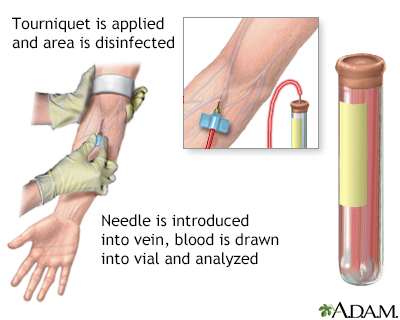Osmolality blood test
Osmolality blood test is a test that measures the concentration of all chemical particles found in the fluid part of blood.
Osmolality in the urine can be measured with a urine test.
Images

I Would Like to Learn About:
How the Test is Performed
How to Prepare for the Test
Follow any instructions from your health care provider about not eating before the test. Your provider may tell you to temporarily stop taking any medicines that may interfere with test results. Such medicines may include water pills (diuretics).
How the Test will Feel
When the needle is inserted to draw blood, some people feel moderate pain. Others feel only a prick or stinging sensation. Afterward, there may be some throbbing or a slight bruise. This soon goes away.
Why the Test is Performed
This test helps check your body's water balance. Your provider may order this test if you have signs of any of the following:
- Low sodium (hyponatremia) or water loss
- Poisoning from harmful substances such as ethanol, methanol, or ethylene glycol
- Problems producing urine
- Excessive thirst
- Excessive urination
In healthy people, when osmolality in the blood becomes high, the body releases antidiuretic hormone (ADH).
This hormone causes the kidneys to reabsorb water. This results in more concentrated urine. The reabsorbed water dilutes the blood. This allows blood osmolality to fall back to normal.
Low blood osmolality suppresses ADH. This reduces how much water the kidneys reabsorb. Dilute urine is passed to get rid of the excess water, which increases blood osmolality back toward normal.
Normal Results
Normal values range from 275 to 295 mOsm/kg (275 to 295 mmol/kg).
Normal value ranges may vary slightly among different laboratories. Some labs use different measurements or test different samples. Talk to your provider about the meaning of your specific test results.
What Abnormal Results Mean
A higher than normal osmolality may be due to:
- Diabetes insipidus
- High blood sugar level (hyperglycemia)
- High level of nitrogen waste products in the blood (uremia)
- High sodium level (hypernatremia)
- Stroke or head trauma resulting in decreased ADH secretion
- Water loss (dehydration)
A lower than normal osmolality may be due to:
- ADH oversecretion
- Adrenal gland not working normally
- Conditions linked to lung cancer (causing syndrome of inappropriate ADH production, or SIADH)
- Other conditions or medicines that cause SIADH
- Drinking too much water or fluid
- Low sodium level (hyponatremia)
- Underactive thyroid gland (hypothyroidism)
Risks
There is little risk involved with having your blood taken. Veins and arteries vary in size from one person to another and from one side of the body to the other. Taking blood from some people may be more difficult than from others.
Other risks associated with having blood drawn are slight but may include:
- Excessive bleeding
- Fainting or feeling lightheaded
- Multiple punctures to locate veins
- Blood accumulating under the skin (hematoma)
- Infection (a slight risk any time the skin is broken)
Related Information
DehydrationAntidiuretic hormone blood test
Diabetes insipidus
Blood sugar test
Sodium blood test
Acute tubular necrosis
Stroke
Prerenal azotemia
Low blood sodium
Lung cancer - small cell
References
Oh MS, Briefel G, Pincus MR. Evaluation of renal function, water, electrolytes, and acid-base balance. In: McPherson RA, Pincus MR, eds. Henry's Clinical Diagnosis and Management by Laboratory Methods. 24th ed. Philadelphia, PA: Elsevier; 2022:chap 15.
Verbalis JG. Disorders of water balance. In: Yu ASL, Chertow GM, Luyckx VA, Marsden PA, Skorecki K, Taal MW, eds. Brenner and Rector's The Kidney. 11th ed. Philadelphia, PA: Elsevier; 2020:chap 15.
BACK TO TOPReview Date: 8/20/2023
Reviewed By: Jacob Berman, MD, MPH, Clinical Assistant Professor of Medicine, Division of General Internal Medicine, University of Washington School of Medicine, Seattle, WA. Also reviewed by David C. Dugdale, MD, Medical Director, Brenda Conaway, Editorial Director, and the A.D.A.M. Editorial team.

Health Content Provider
06/01/2025
|
A.D.A.M., Inc. is accredited by URAC, for Health Content Provider (www.urac.org). URAC's accreditation program is an independent audit to verify that A.D.A.M. follows rigorous standards of quality and accountability. A.D.A.M. is among the first to achieve this important distinction for online health information and services. Learn more about A.D.A.M.'s editorial policy, editorial process and privacy policy. A.D.A.M. is also a founding member of Hi-Ethics. This site complied with the HONcode standard for trustworthy health information from 1995 to 2022, after which HON (Health On the Net, a not-for-profit organization that promoted transparent and reliable health information online) was discontinued. |
The information provided herein should not be used during any medical emergency or for the diagnosis or treatment of any medical condition. A licensed medical professional should be consulted for diagnosis and treatment of any and all medical conditions. Links to other sites are provided for information only -- they do not constitute endorsements of those other sites. © 1997- 2025 A.D.A.M., a business unit of Ebix, Inc. Any duplication or distribution of the information contained herein is strictly prohibited.
